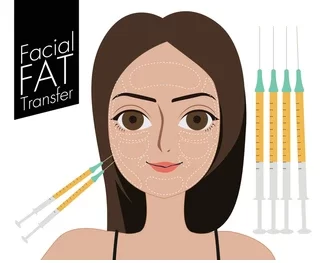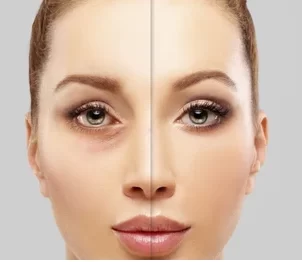1. Introduction
As we age, our faces naturally undergo a process called facial volume loss. This is due to a combination of fat loss, bone resorption, and thinning of the skin. These changes can cause:
Flattened cheeks
Hollow temples
Deepened folds around the mouth
Sharper, more tired-looking contours
One of the most effective and natural ways to address this is through Autologous Fat Grafting.
Autologous means “from your own body.” In this procedure, a surgeon removes fat from one area — usually the abdomen, flanks, or thighs — processes it to remove impurities, and then carefully injects it into targeted facial areas that need volume.
Because the fat comes from you, it is 100% biocompatible, meaning there is no risk of rejection or allergic reaction. When performed skillfully, the results are soft, natural, and long-lasting.
2. Common Indications
Autologous fat grafting can be used for both cosmetic rejuvenation and corrective purposes.
Cosmetic Rejuvenation:
Nasolabial folds – Softens deep creases between the nose and mouth
Malar eminence (cheekbones) – Restores youthful cheek projection
Temporal fossa (temples) – Fills hollow areas for smoother forehead contour
Jawline – Improves definition and contour
Chin and pre-jowl sulcus – Balances proportions, reduces sagging appearance
Full-face volumization – Softens overall features and improves harmony
Corrective Uses:
Contour irregularities – Smooths depressions from trauma or previous surgery
Adjunct to facelifts – Complements skin tightening by restoring underlying volume
Scar depressions – Improves texture and contour in atrophic scars
3. Types of Anaesthesia
The level of anaesthesia depends on the volume of fat being transferred, the number of treatment areas, and patient comfort:
Local anaesthetic – For small, single-area fat transfers (e.g., just nasolabial folds)
Local anaesthetic + sedation – For moderate procedures or multiple areas without general anaesthesia
General anaesthetic – For full-face volumization or when combined with other facial surgeries like a facelift or eyelid surgery
4. Step-by-Step Technique
The procedure has three main stages: harvesting, processing, and injection.
Step 1 – Harvesting
A small amount of fat is removed using gentle liposuction.
Common donor sites: abdomen, flanks, inner/outer thighs.
Fine, blunt-tipped cannulas are used to minimise trauma to the fat cells.
Step 2 – Processing
The harvested fat contains not only viable fat cells but also oil, blood, and tumescent fluid from the liposuction process.
These impurities must be removed for better graft survival.
Processing methods include:
Centrifugation (Coleman technique) – Spinning the fat to separate viable cells from oil and water
Decanting – Letting fat settle by gravity, draining away excess fluid
Filtration – Passing fat through sterile filters to remove debris
Step 3 – Injection
Purified fat is drawn into small syringes and injected into the target area.
The surgeon uses microdroplet technique, placing tiny amounts of fat in multiple layers.
This maximises surface area contact with surrounding tissue, allowing the fat to develop a new blood supply and survive long-term.

5. Advantages of Autologous Fat Grafting
Natural filler – Uses your own tissue, no synthetic implants
Biocompatible – No risk of allergy or immune rejection
Skin quality improvement – Fat contains stem-cell-rich fractions that may improve texture and elasticity
Long-term potential – Surviving fat cells are permanent
Multi-area treatment – Can address several facial regions in one session
Can be combined – Works well with facelifts, eyelid surgery, or skin resurfacing
6. Limitations
Variable fat survival – On average, 50–70% of transferred fat survives long-term
Possible repeat treatments – Larger volume restoration often needs 2–3 sessions
Dependent on patient factors – Smoking, poor circulation, and certain medical conditions can reduce fat survival
Subtlety – Changes are natural rather than dramatic after one session
7. Multi-Stage Nature of Treatment
Fat graft survival is partly unpredictable.
Surgeons often slightly overfill the area to account for natural resorption, but final touch-ups may be needed.
Typical pattern:
First 3 months – Fat resorption stabilises
After 6 months – Surviving fat is permanent
8. Possible Complications (Uncommon)
Temporary swelling and bruising – Most common, resolves in 2–3 weeks
Donor site discomfort – Mild soreness similar to small-area liposuction
Lumpiness or unevenness – Usually improves with massage or minor revision
Asymmetry – Correctable with touch-up injections
Fat necrosis – Small firm nodules from fat cells that don’t survive
Oil cysts – Benign pockets of liquefied fat
Infection – Rare, treated with antibiotics
Vascular embolism – Extremely rare but serious; careful injection technique reduces this risk
9. Recovery & Aftercare
Day 1–3 – Swelling and bruising peak
Week 1–2 – Most swelling resolves, bruising fades
Week 3+ – Return to normal appearance, though mild swelling may linger
Month 3–6 – Final shape and contour stabilise
Post-care tips:
Avoid pressing or sleeping on treated areas for 2 weeks
Maintain a healthy diet and avoid smoking to support graft survival
Avoid intense exercise for the first week
Keep follow-up appointments for monitoring and adjustments
10. Evidence-Based References
Coleman SR. Structural fat grafting: more than a permanent filler. Plast Reconstr Surg. 2006;118(3 Suppl):108S–120S.
Pu LLQ. Mechanisms of fat graft survival. Ann Plast Surg. 2016;77(Suppl 1):S84–S86.
Kanchwala SK, Bucky LP. Facial fat grafting: the new paradigm. Plast Reconstr Surg. 2008;122(2):496–502.
Khouri RK, Rigotti G, Cardoso E, et al. Tissue-engineered breast reconstruction with Brava-assisted fat grafting. Plast Reconstr Surg. 2012;129(5):1173–1187.
Li Q, Zhang H, Liu X, et al. Autologous fat grafting for facial rejuvenation: a systematic review and meta-analysis. Aesthetic Plast Surg. 2021;45(5):2130–2143.
11. Summary for Patients
Autologous fat grafting is one of the most natural and long-lasting ways to restore youthful facial contours. It offers:
Soft, natural results
No synthetic materials
Potential skin quality improvement
However, it’s important to understand:
Some fat will be reabsorbed naturally
More than one session may be needed
Final results take several months to fully appear
With a skilled surgeon and realistic expectations, autologous fat grafting can refresh your appearance while keeping your individuality intact.
Contact MACS Clinic
📞 Phone: 020 7078 4378
💬 WhatsApp: 07792 648 726
📧 Email: enquiries@macsclinic.co.uk
🌐 Website: macsclinic.co.uk







